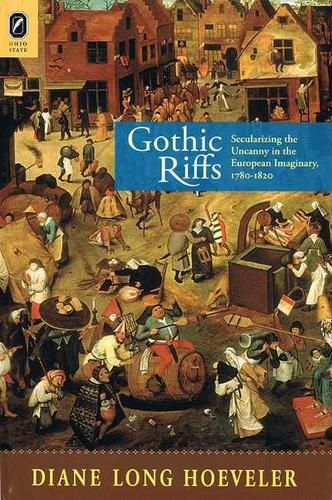Readings Newsletter
Become a Readings Member to make your shopping experience even easier.
Sign in or sign up for free!
You’re not far away from qualifying for FREE standard shipping within Australia
You’ve qualified for FREE standard shipping within Australia
The cart is loading…






This title is printed to order. This book may have been self-published. If so, we cannot guarantee the quality of the content. In the main most books will have gone through the editing process however some may not. We therefore suggest that you be aware of this before ordering this book. If in doubt check either the author or publisher’s details as we are unable to accept any returns unless they are faulty. Please contact us if you have any questions.
Gothic Riffs: Secularizing the Uncanny in the European Imaginary, 1780-1820 by Diane Long Hoeveler provides the first comprehensive study of what are called collateral gothic genres–operas, ballads, chapbooks, dramas, and melodramas–that emerged out of the gothic novel tradition founded by Horace Walpole, Matthew Lewis, and Ann Radcliffe. The role of religion and its more popular manifestations, superstition and magic, in the daily lives of Western Europeans were effectively undercut by the forces of secularization that were gaining momentum on every front, particularly by 1800. It is clear, however, that the lower class and the emerging bourgeoisie were loath to discard their traditional beliefs. We can see their search for a sense of transcendent order and spiritual meaning in the continuing popularity of gothic performances that demonstrate that there was more than a residue of a religious calendar still operating in the public performative realm. Because this bourgeois culture could not turn away from God, it chose to be haunted, in its literature and drama, by God’s uncanny avatars: priests, corrupt monks, incestuous fathers and uncles. The gothic aesthetic emerged during this period as an ideologically contradictory and complex discourse system; a secularizing of the uncanny; a way of alternately valorizing and at the same time slandering the realms of the supernatural, the sacred, the maternal, and the primitive.
$9.00 standard shipping within Australia
FREE standard shipping within Australia for orders over $100.00
Express & International shipping calculated at checkout
This title is printed to order. This book may have been self-published. If so, we cannot guarantee the quality of the content. In the main most books will have gone through the editing process however some may not. We therefore suggest that you be aware of this before ordering this book. If in doubt check either the author or publisher’s details as we are unable to accept any returns unless they are faulty. Please contact us if you have any questions.
Gothic Riffs: Secularizing the Uncanny in the European Imaginary, 1780-1820 by Diane Long Hoeveler provides the first comprehensive study of what are called collateral gothic genres–operas, ballads, chapbooks, dramas, and melodramas–that emerged out of the gothic novel tradition founded by Horace Walpole, Matthew Lewis, and Ann Radcliffe. The role of religion and its more popular manifestations, superstition and magic, in the daily lives of Western Europeans were effectively undercut by the forces of secularization that were gaining momentum on every front, particularly by 1800. It is clear, however, that the lower class and the emerging bourgeoisie were loath to discard their traditional beliefs. We can see their search for a sense of transcendent order and spiritual meaning in the continuing popularity of gothic performances that demonstrate that there was more than a residue of a religious calendar still operating in the public performative realm. Because this bourgeois culture could not turn away from God, it chose to be haunted, in its literature and drama, by God’s uncanny avatars: priests, corrupt monks, incestuous fathers and uncles. The gothic aesthetic emerged during this period as an ideologically contradictory and complex discourse system; a secularizing of the uncanny; a way of alternately valorizing and at the same time slandering the realms of the supernatural, the sacred, the maternal, and the primitive.